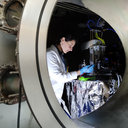
Silvia MasilloUniversity of Surrey · Surrey Space Centre (SSC)
Silvia Masillo
M.Sc. Space and Astronautical Engineering
About
12
Publications
4,628
Reads
How we measure 'reads'
A 'read' is counted each time someone views a publication summary (such as the title, abstract, and list of authors), clicks on a figure, or views or downloads the full-text. Learn more
52
Citations
Introduction
Skills and Expertise
Additional affiliations
October 2018 - present
January 2018 - October 2018
Education
January 2016 - July 2016
October 2015 - October 2018
October 2011 - March 2015
Publications
Publications (12)
The Air-breathing Microwave Plasma CAThode (AMPCAT) has been developed for air-breathing electric propulsion in very-low Earth orbit. In this study, the standalone AMPCAT plasma characteristics are analyzed by means of several diagnostic tools and operation on xenon is compared to a conventional hollow cathode. A transition of AMPCAT extracted curr...
A hollow cathode with a modular design has been developed to assist with laboratory testing of plasma-based thrusters for satellite applications. This novel modular design includes interchangeable components for varying the geometry and tailoring the configuration to specific applications, as well as easing the replacement of individual components...
A hollow cathode with a modular design has been developed to assist with laboratory testing of plasma-based thrusters for satellite applications. This novel modular design includes interchangeable components for varying the geometry and tailoring the configuration to specific applications, as well as easing the replacement of individual components...
A torsional thrust balance has been designed and validated by Surrey Space Centre and Added Value Solutions UK Ltd. in collaboration with the UK Space Agency. The thrust stand has been tested with two electric propulsion (EP) systems operating with xenon: the Halo thruster and the XJET thruster. The first consists of a low-power (<1 kW) Hall effect...
AVS UK has designed, built, and tested a torsional thrust balance system with wireless radio frequency (RF) power transfer at the electric propulsion lab at the Surrey Space Centre (SSC). Following integration, and characterisation tests such as wireless power transfer efficiency, and thermal drift, it was used for the main test campaign of AQUAJET...
Electrodeless plasma thrusters, and in particular Electron Cyclotron Resonance (ECR) thrusters, are attracting an increasing amount of commercial and academic interest by virtue of their ability to function without a neutralizer. This opens the door to operation with a wide range of alternative propellants all the while ensuring mitigation of some...
This paper presents an overview of recent experimental research and development activities performed on a Halo thruster permanent-magnets prototype operated on xenon. The thruster performance is assessed for different power levels and mass flow rates. The thrust, measured using a pendulum-type thrust balance, ranges from 5.9 to 12.6 mN for anode di...
We have designed, built and tested a new thrust balance system as an upgrade for the Electric Propulsion lab at the Surrey Space Centre (SSC). Following this proof-of-concept, our balance design will be developed as a commercial unit for other propulsion test facilities, and used in AVS' own propulsion development including microwave powered thrust...
Orbiting at lower orbital altitudes, where the residual atmosphere is source of aerodynamic drag requires an efficient drag-compensation system for satellite lifetime extension. One solution is proposed by using Atmosphere-Breathing Electric Propulsion (ABEP), a system that collects atmospheric particles and directly uses them as propellant for an...
LEDSAT is a 1U CubeSat developed by S5Lab team of Sapienza – University of Rome in collaboration with the Astronomy Department of University of Michigan. The main goal of the mission is to demonstrate that a LED-based active illumination system may be used to achieve orbit and attitude determination. LEDSAT will be placed into a Low Earth Orbit (LE...













































![Figure 3. Electromagnetic fields generated in inductive mode[16].](profile/Francesco-Romano-4/publication/331479205/figure/fig1/AS:732353265688580@1551618033792/Electromagnetic-fields-generated-in-inductive-mode16_Q320.jpg)



















